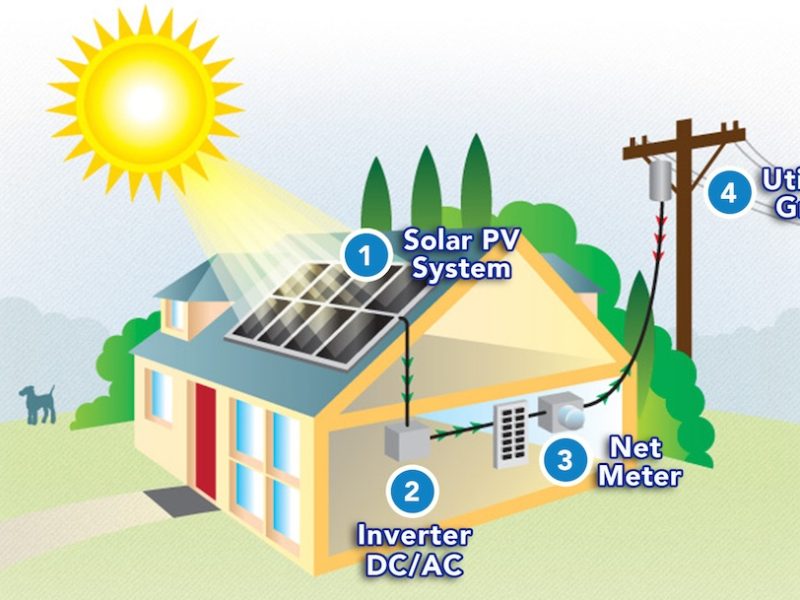Net metering plays a vital role in the solar energy sector, providing a method for individuals and businesses to not just generate their power but also to send excess electricity back to the grid. This innovative billing system is instrumental in driving the adoption of solar energy, promoting sustainability, and enabling cost savings. Here’s how net metering operates:
Solar energy setups, typically comprised of solar panels installed on roofs or properties, capture sunlight and convert it into electrical energy. This generated power is primarily used to operate appliances, lighting, and other devices within the building. However, if the solar panels generate more electricity than is immediately required, the surplus energy is fed back into the grid.
Key to the functioning of net metering is the installation of a bi-directional meter. This specialized meter accurately measures both the electricity drawn from the grid and the surplus electricity transmitted to it. With electricity flowing in two directions, the meter records consumption when power is drawn from the grid and grants credits when surplus electricity is returned.
What is net metering with solar energy?
Net metering coupled with solar energy is a billing arrangement enabling individuals or businesses equipped with solar panels to mitigate their electricity expenses by producing surplus electricity and returning it to the grid. Here’s a typical overview of how it functions:
Solar Energy Generation:
Solar panels installed on rooftops or properties harness sunlight to generate electricity, catering to the power needs of appliances, lighting, and other electrical devices within the premises.
Excess Electricity:
Any surplus electricity generated by the solar panels beyond immediate on-site requirements is transmitted back into the grid.
Bi-Directional Metering:
A specialized bi-directional meter is installed to measure both the electricity drawn from and supplied to the grid. This meter accurately records the flow of electricity in both directions.
Net Metering Calculation:
At the close of a billing period, often monthly, the utility provider computes the net electricity usage by subtracting the surplus electricity exported to the grid from the electricity consumed from it.
Credit for Surplus Electricity:
Should the solar system yield more electricity than consumed from the grid during the billing cycle, the customer earns credits for the surplus electricity. These credits are typically carried forward and applied to subsequent electricity bills.
Billing:
Customers receive electricity bills reflecting the net amount of electricity consumed from the grid after factoring in any surplus electricity generated by their solar panels.
- Net metering effectively enables solar system owners to offset their electricity expenses by feeding surplus electricity into the grid. It promotes the uptake of solar energy by offering financial incentives and advancing renewable energy utilization. Additionally, net metering aids in grid stability by balancing supply and demand, thereby diminishing the necessity for further investments in grid infrastructure. Nonetheless, the specifics of net metering policies and regulations may vary based on location and utility provider, necessitating an understanding of the applicable rules and requirements for solar system owners.
How does net metering work with solar energy?
Solar Energy Generation:
When a solar energy system generates electricity, it primarily powers the immediate needs of the home or business. Any excess power beyond current demand is directed into the grid.
Bi-Directional Metering:
A bi-directional meter is installed to gauge both the electricity drawn from the grid and the surplus electricity transmitted back to it. This meter tracks electricity usage forwards when drawing from the grid and backwards when exporting surplus power.
Net Metering:
At the end of a billing period, usually monthly, the utility provider calculates the net electricity usage by deducting the exported electricity from the electricity consumed from the grid. If the solar system generates more electricity than what’s drawn from the grid, the surplus is credited to the customer.
Credit and Billing:
Customers receive credits on their electricity bills for the excess electricity generated and fed back into the grid. These credits are typically applied at the retail rate, aligning with the standard rate for grid electricity consumption. Occasionally, the credits may be applied at a reduced rate.
Carryover and Settlement:
Depending on the specific net metering policy in place, any surplus credits accrued during one billing period may either roll over to the subsequent period or be reconciled annually. If rolled over, these credits can offset future electricity charges. If reconciled annually, the utility might reimburse the customer for any remaining credits at the end of the settlement period.
- Net metering facilitates solar system owners in offsetting their electricity costs by exporting surplus power to the grid, thereby promoting the adoption of solar energy while ensuring equitable compensation for generated electricity. It supports grid stability by leveraging distributed generation and diminishes the necessity for further investments in grid infrastructure. Nevertheless, net metering policies and regulations are subject to variation based on location, underscoring the importance for solar system owners to grasp the specific guidelines and prerequisites applicable in their vicinity.












